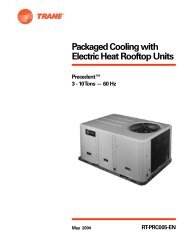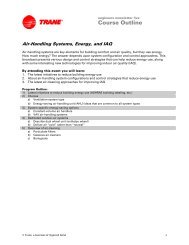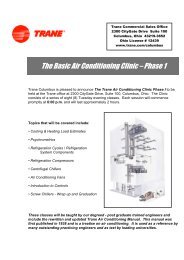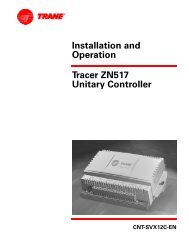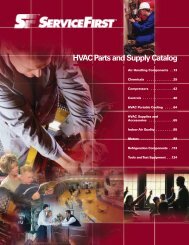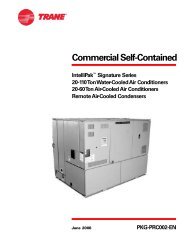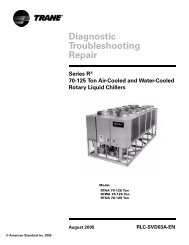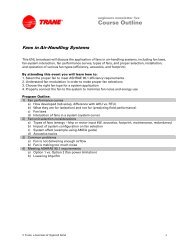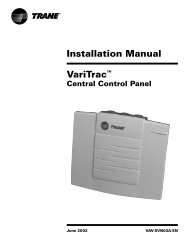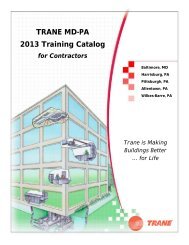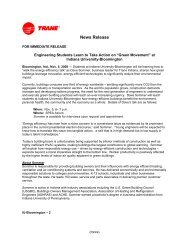T-Series Climate Changer ® Air Handlers Sizes 3 through ... - Trane
T-Series Climate Changer ® Air Handlers Sizes 3 through ... - Trane
T-Series Climate Changer ® Air Handlers Sizes 3 through ... - Trane
Create successful ePaper yourself
Turn your PDF publications into a flip-book with our unique Google optimized e-Paper software.
T-<strong>Series</strong> Outside <strong>Air</strong> Inlet Hood CFM<br />
Limitations<br />
Each T-<strong>Series</strong> unit has a rated nominal<br />
cfm (a #3 for example is 1,500 cfm).<br />
These nominal cfm’s allow for an<br />
engineer to quickly base his unit size<br />
requirements. Although this is the<br />
nominal cfm of a given unit, each unit<br />
is capable of producing more cfm, until<br />
something limits the ability of the unit<br />
to meet this higher cfm requirement<br />
such as coil face velocity, filter face<br />
velocity or the outside air inlet hood<br />
eliminator velocity.<br />
The eliminator in the inlet hood is rated<br />
to a maximum of 950 feet per minute.<br />
Above this limit, there is a high<br />
probability of bringing rain water or<br />
snow into the unit, which could migrate<br />
to the conditioned space below. When<br />
selecting units for your application,<br />
remember not to undersize a unit to the<br />
point that the inlet hood eliminators<br />
can not handle the outside air cfm<br />
requirements.<br />
In Table A-4 are the maximum cfm’s for<br />
the inlet hoods on the back and sides of<br />
a mixing module and the side inlet<br />
hoods on an economizer module.<br />
Applications<br />
Table A-4 — Inlet Hood CFM Limitations<br />
Mixing Module Economizer Module<br />
Back Inlet 1 Side 2 Side Single Dual<br />
Unit Size Hood Inlet Hood Inlet Hoods Inlet Hood Inlet Hoods<br />
3 2,337 1,862 3,724 1,862 3,724<br />
6 3,876 1,976 3,952 1,976 3,952<br />
8 4,341 2,384 4,769 2,384 4,769<br />
10 8,949 3,135 6,270 3,135 6,270<br />
12 9,614 3,752 7,505 3,752 7,505<br />
14 10,193 4,314 8,626 4,314 8,626<br />
17 13,870 5,111 10,222 5,111 10,222<br />
21 14,288 5,776 11,552 5,776 11,552<br />
25 17,755 6,773 13,547 6,773 13,547<br />
30 20,786 8,303 16,606 8,303 16,606<br />
35 25,251 9,547 19,095 9,547 19,095<br />
40 28,756 10,858 21,717 10,858 21,717<br />
50 31,825 13,528 27,056 13,528 27,056<br />
66 41,116* 18,078 36,157 18,078 36,157<br />
80 46,217* 21,517 43,035 21,517 43,035<br />
100 57,152* 26,191 52,383 26,191 52,383<br />
*For units with Traq dampers located in the back inlet position of a mixing module, use the two-sided inlet hood limits for<br />
a mixing module.<br />
Example:<br />
Assume you are selecting a #10 exhaust fan economizer unit at 5,000 cfm and .5”<br />
ESP consisting of:<br />
Exhaust damper module<br />
Fan module<br />
Mixing module<br />
Medium access module<br />
Angle filter module<br />
Heating coil module<br />
Cooling coil module<br />
Fan module<br />
Specification requires that no more than 50 percent of the cfm will come from<br />
outside air. In this example, the unit could be supplied with one-sided inlet hood,<br />
as the maximum cfm <strong>through</strong> one-sided hood is 3,135.<br />
If 100 percent outside air capability were specified, then the unit would need to be<br />
supplied with two-sided inlet hoods.<br />
22




